Organizational Competition
We are now empowered to view the “Air Wars” with x-ray vision. We will use New Capital Development Models to view both Airbus and Boeing.
- The Battlefield was determined by marketplace positioning. We will see their differences through the MCD–Marketplace Positioning Model.
- Battlefield formations were designed by each company’s chosen organizational resource alignment. Their differences are presented in the OCD–Organizational Alignment Model.
- Battlefield soldiers were empowered by their levels of generative human processing. Their differences are revealed in the HCD–Human Processing Model.
- Battlefield intelligence was measured by the quality of each company’s information models. The ICD–Information Capital Model maps the differentiated information modeling orientation of each company.
- Battlefield weaponry was defined by each company’s mechanical tools. The mCD–Mechanical Tooling Model presents the differentiated mechanical tooling of each company.
Together, the New Capital Development Models show how even a partial adoption of NCD ingredients resulted in Airbus winning the commercial production “Air Wars” with Boeing.
The Battlefield—Marketplace Positioning
The marketplace battles began with the positioning defined by assembling the scaled levels. The scales operationalize multidimensional models that generate comparative analyses of the companies’ positioning.
In the MCD Positioning Model, the phases of the Market Lifecycle enable the corporate capacities to accomplish their NCD market requirements (see Figure 57). As may be viewed, members of Boeing’s Board of Directors emphasized the Commoditizer Phase as the set of processes for empowering the IT and mT technologies to achieve their IC and mC requirements. In short, Boeing is positioned by Commoditizing and Attenuating to accomplish its IC and mC functions.
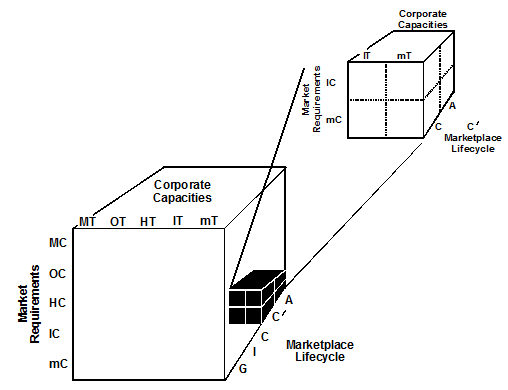
Figure 57. The MCD Model (Boeing)
In building the MCD Positioning Model, members of the Board of Directors of Airbus emphasized the Innovator Phase for empowering their NCD technologies to accomplish their IC and mC market functions (see Figure 58). They also developed GIC teams to synergistically Generate, Innovate, and Commercialize their product lines. In short, Airbus is positioned by Innovator to accomplish its IC–mC functions.
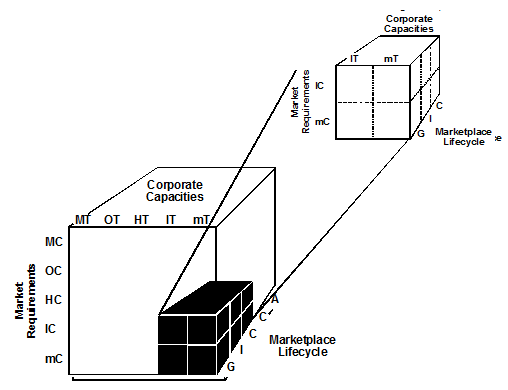
Figure 58. The MCD Positioning Model (Airbus)
The MCD battleground is the comparative analysis of MCD Positioning Models. On the face of it, Airbus is positioned on “the commanding heights.” It has the most fully developed model for Market Requirements and Corporate Capacities. It is positioned to maximize the Innovator Phase of Marketing.
Airbus’ positioning emphasizes the following:
- All Market Phases contributing to continuous Innovator Phase processes through the “GIC” team;
- Fully-empowered Corporate Technological Capacities contributing to IT and mT components;
- Fully-developed NCD contributing to ICD and mCD functions.
In turn, Boeing’s positioning emphasizes the following:
- Time-limited Commoditizer Phase processes;
- Time-limited Corporate Technological Capacities in IT and mT components;
- Time-limited NCD contributing to IC and mC functions.
In short, Airbus is prepared to get there “firstest with the mostest” and to stay there “longest with the bestest.”
To sum, Airbus has fully-developed and continuous regenerating systems to define its continuously-evolving Innovator marketplace positioning.
In contrast, Boeing has limited and legacy-bound systems to define its relatively static Commoditizer marketplace positioning.
The MCD battles were over before they started! As when Colonel Buford assumed the commanding heights of Cemetary Ridge at Civil War Gettysburg, the victors and the vanquished were defined by their positioning!
One company took the processing offensive, ultimately culminating in interdependent processing that generated a continuous flow of new marketing standards. The other took the conditioning defensive, emphasizing time-limited and attenuating legacy learning.
One company became empowered in generative processing—although not without obstacles. With 360 degrees of freedom, its race was up and to the front.
Battlefield Formations—Organizational Alignment
The corporations were organized in battlefield formations. We will use the OCD Organizational Alignment Model for a comparative analysis of comprehensiveness of organizational processing.
As may be noted in Figure 59, Boeing occupies very few cells of the OCD Model—twenty-four cells or fewer than 20% of the possible cells, to be precise! Basically, Boeing’s organization model is a 3 x 2 x 4 design:
- Management-Driven Market Functions,
- Technology-Driven Organizational Components,
- Planning-Driven Human Processes.
The Boeing OCD Model is defined as follows:
Management-Driven Functions are discharged by Technology-Driven Components, enabled by Planning Processes.
Is this sufficient to win the OCD battle? For the moment, suffice it to say that Boeing is recognized as an exemplary performer in management systems, technology components, and planning processes.
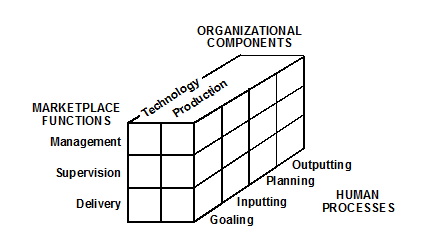
Figure 59. OCD Model (Boeing)
In turn, Airbus’ battlefield formation was formidable (see Figure 60). Basically, Airbus’ leaders adopted the comprehensive OCD Model:
- Policy-Driven Market Functions,
- Leadership-Driven Organizational Components,
- Goaling-Driven Human Processes.
The Airbus OCD Model is defined as follows:
Policy-Driven Functions are discharged by Leadership-Driven Components enabled by Goaling-Driven Processes.
Is this a sufficient formation to win the OCD battle? Only a comparative analysis would yield the answer!
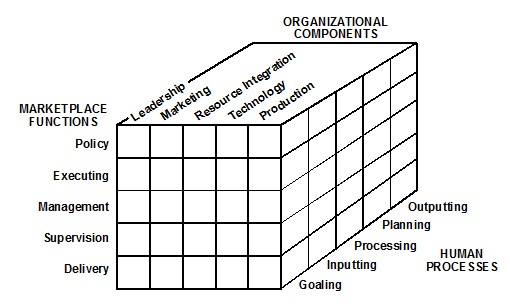
Figure 60. OCD Model (Airbus)
A comparative analysis of the OCD models reveals the obvious. Boeing has only a partial OCD Model. Airbus has a comprehensive OCD Model. Even this does not tell the whole story.
The OCD Functions story is this:
Policy Mission:
- Airbus has an MCD mission of interdependent and continuous repositioning in constantly-changing marketplace conditions.
- Boeing has an independent mission that does not involve continuous repositioning.
Executive Architecture:
- Airbus has an interdependent OCD architecture of continuous realignment of resources to implement continuous repositioning.
- Boeing has an independent architecture that does not involve continuous realignment.
Management Systems:
- Airbus has continuously redesigned interdependent HCD systems dedicated to empowering people to achieve changing goals of the realigning resources.
- Boeing has independent, top-down, traditional management-driven functions.
Supervisory Objectives:
- Airbus has interdependent ICD operations dedicated to continuously redefining information modeling objectives for changing systems generated by HCD.
- Boeing has linear and independent ICD operations dedicated to information modeling.
Delivery Programs:
- Airbus has interdependent mCD operations dedicated to continuously redesigning mechanical tooling programs and tasks to achieve changing information modeling objectives.
- Boeing has linear and independent mCD operations dedicated to mechanical tooling.
Here is the OCD Components story:
Leadership Component:
- Airbus has Leadership-driven Components dedicated to implementing MCD Positioning.
- Boeing does not have Leadership-driven Components (because it does not know how to generate or discriminate MCD Codes).
Marketing Component:
- Airbus has Marketing Components dedicated to obtaining Customers’ OCD Coding.
- Boeing does not have coding-dedicated Marketing Components (because it does not know how to generate or discriminate Customer OCD Codes).
Resource Integration:
- Airbus has Resource Integration Components to generate tailored products aligned with the Customers’ Codes.
- Boeing does not have dedicated tailoring units (again, because it does not have OCD Codes).
Technology Component:
- Airbus has Technology Components dedicated to customizing tailored products.
- Boeing’s customizing units are variations of standardizing rather than of tailoring.
Production Components:
- Airbus has Production Components dedicated to standardizing customized products.
- Boeing has standardizing units.
Finally, here is the OCD Processes story:
Goaling:
- Airbus has S–MP–R Marketplace Processing Systems for defining values and requirements for MCD processing.
- Boeing does not have systematic processing systems for goaling (because it does not have MCD Coding).
Inputting:
- Airbus has S–OP–R Organizational Processing Systems for obtaining current images of OCD operations.
- Boeing does not have systematic processing systems for organizational inputting (again, because it does not have OCD Coding).
Processing:
- Airbus has S–P–R Processing Systems for generating new images of new operations.
- Boeing has little or no interest in new images of new operations (because it is legacy-bound).
Planning:
- Airbus has S–O–R Learning Systems for designing new systems and objectives.
- Boeing has S–R Planning Systems for supporting CAD systems and objectives.
Outputting:
- Airbus has S–R Conditioning Systems for implementing programs.
- Boeing has s–r Chaining Systems for implementing programs.
Here, then, is the whole story:
Functions:
- Airbus is positioned by continuous interdependent processing systems that accelerate changeability.
- Boeing is positioned by constantly-refined linear legacy systems that narrow variability.
Components:
- Airbus is driven by continuously-upgraded coding for leadership and customers that generate uniquely-tailored products.
- Boeing is driven by constantly-refined customized products.
Processes:
- Airbus is empowered by continuous and comprehensive, interdependent processing systems.
- Boeing is enabled by limited and independent, linear branching systems.
To sum, Airbus is committed to change: not only to responding to change, but also to initiating change by interdependently generating a spiraling array of futuristic standards for the air industry.
In turn, Boeing is committed to stasis: to developing successive approximations of its historic legacy theme.
In short, Airbus is the OCD Model! It has arraigned its battlefield formations accordingly.
Boeing is simply a model for the past ways of doing things!
Battlefield Soldiers—Human Processing
Both Boeing and Airbus managers initiated their HCD model-building with the scales that they inherited from the executives, the components and processes of their OCD systems. Simultaneously, they introduced the Information Capital Development or ICD Systems to enable the HCD Components to accomplish the OCD Functions.
Armed with these enabling ICD Processes, the managers of both Boeing and Airbus were able to define their models for HCD. As may be noted in Figure 61, the Boeing model was a limited version of HCD.
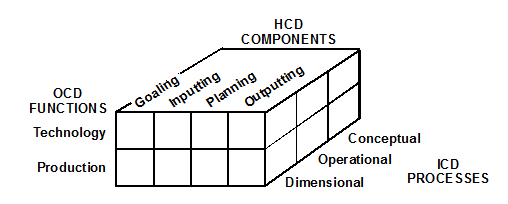
Figure 61. HCD Model (Boeing)
For Boeing, two levels of OCD Functions—Technology and Production—are accomplished by four levels of HCD Components—absent the Processing Component. All of this is enabled by a limited version of the ICD Processes.
In turn, the Airbus HCD Model is comprehensive (see Figure 62). All levels of OCD Functions are discharged by all levels of HCD Components enabled by all levels of ICD Processes.
The contrast between Boeing and Airbus HCD Models is apparent: the former (24 cells) would fit nicely in the 125 cells of the latter.
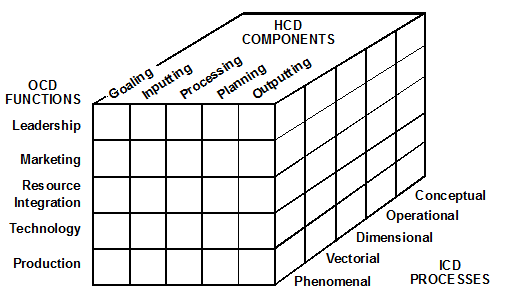
Figure 62. HCD Model (Airbus)
Both companies are presenting their images of human potential in their HCD Models. In the case of Boeing, we might more appropriately label their model an HRD or Human Resource Development Model. The HRD Model places no emphasis upon systematic training for generative processing that takes place in the HCD Processes. The HRD efforts center around supporting the CAD/CAM systems.
In contrast, Airbus represents a comprehensive and robust HCD Model emphasizing generative processing dedicated to all levels of OCD Functions. While it addresses the Information Age Threshold, it does not cross into the Age of Ideation. Specifically, there is no systematic skills training in Possibilities Thinking or Generative Processing. Nevertheless, the human processes have the guidance and direction from the MCD and OCD levels.
To sum, Airbus places a formidable array of units on the battlefield. However, in some instances, such as in generative processing, it has idealized images that eclipse its unrealized resources. Nevertheless, we may view the system as a “Man-CAD” system where HCD collaborative processing drives the CAD/CAM systems.
Boeing, in turn, has no illusions about its people. The dominant image resurrects the Industrial Age image of “Machine/Man,” with an emphasis upon the machine. It is truly a CAD-Man system!
Battlefield Intelligence—Information Modeling
Boeing and Airbus supervisors initiated their ICD Model-building with the scales that they inherited from the managers, the components and processes of their HCD Models. Simultaneously, they introduced the Mechanical Capital Development or mCD Processes to enable the ICD Components to accomplish the HCD Functions.
Thus, armed with these enabling mCD Processes, the supervisors of Boeing were able to define a limited model for ICD. As may be noted in Figure 63, the Boeing model was characterized by the absence of HCD Processing Functions; the absence of Phenomenal and Vectorial Components in the ICD Components; and the presence of all mCD Processes. All of this culminated in a limited ICD Model that is more mechanically sound than processing-potent.
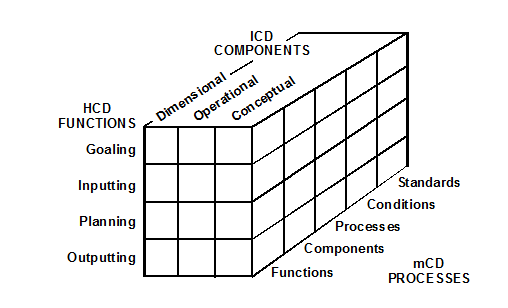
Figure 63. The ICD Model (Boeing)
In turn, the Airbus ICD Model was comprehensive (see Figure 64). All levels of HCD Functions are discharged by all levels of ICD Components enabled by all levels of mCD Processes. The contrast between Boeing and Airbus ICD Models is vivid: the former (60 cells) consists of fewer than one-half of the 125 cells of the latter.
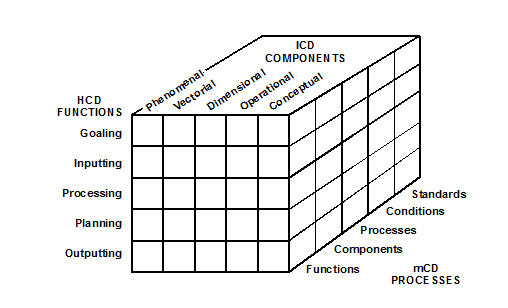
Figure 64. The ICD Model (Airbus)
Both companies are presenting their images of the potential of Information Capital in their ICD Models. Indeed, Boeing’s ICD Model is a mixed model, missing both processing functions and information components. In a very real sense, Boeing presents its Battlefield Intelligence picture sans higher-order processing.
In contrast, Airbus represents a very comprehensive and robust ICD Model emphasizing synergistic processing between all levels of HCD and ICD. Nevertheless, there is no systematic skills training in Information Representation to produce a continuously-elevating level of all NCD resources.
To sum, while Boeing presents an image of Battlefield Intelligence without the highest levels of human and information synergy, Airbus presents a very powerful model for Battlefield Intelligence. It is comprehensive in its Human Processing Functions, its Information Modeling Components and its Mechanical Tooling Processes. It yields a complete and continuous moment-to-moment picture of the ICD required for elevating NCD.
Battlefield Weaponry—Mechanical Tooling
Boeing and Airbus production and delivery people initiated their mCD Model-Building with scales they inherited from the components and processes of the ICD Models. Simultaneously, they introduced the sub-Mechanical Capital Development or mCD¢ Processes to enable the mCD Components to accomplish the ICD Functions.
Thus, armed with these enabling mCD¢ Processes, the delivery personnel at Boeing were able to define a more expanded model for mCD (see Figure 65). Limited only by their inherited ICD Functions, the mCD Components and mCD¢ Processes were inclusive: comprehensive mCD Components and mCD¢ Processes were dedicated to limited ICD Functions.
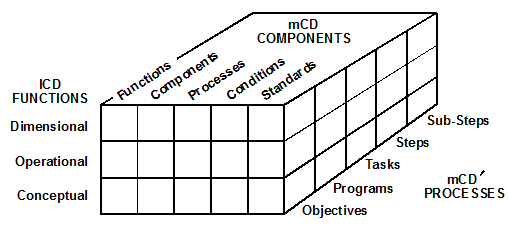
Figure 65. Model for mCD (Boeing)
In turn, the Airbus mCD Model was again comprehensive (see Figure 66). All levels of ICD Functions were discharged by all levels of mCD Components enabled by mCD¢ Processes. Once again, the limitations of the ICD Functions presents a vivid image of the contrast between Boeing and Airbus models: the former is simply not addressing the ICD necessary functions to compete effectively with the latter.
Both companies present powerful images of mechanical potential in their mCD Models. Airbus represents a very robust mCD Model to complement its comprehensive NCD Models: MCD, OCD, HCD, ICD. Unfortunately, Boeing’s legacy systems have left the company with a limited ICD inheritance. In a very real sense, Boeing presents a picture of Battle Weapons of lower-order power, as its people simply follow the mechanical operations of its “CAD-Man” System.
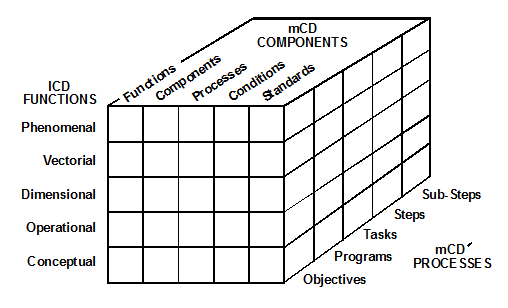
Figure 66. Model for mCD (Airbus)
Once again, differentiated assumptions lead to differentiated implications. Boeing is dedicated to the finite variations of legacy learning. Airbus is dedicated to the potentially infinite variations of generative processing and innovative applications. One has a history. The other has a future!
The implications for the Possibilities Economy are profound. As the global economy becomes integrated and interdependent, marketplace positioning likewise becomes interdependent and integrated. Financial capital continues to obey the basic laws of economics: financial resources are continuously invested and reinvested in the most-valued uses. As interdependent global economy funds migrate freely to realize the best returns, financial capital will “chase” the most powerfully positioned companies into the future.
Again, managing marketplace positioning projects the business and its enterprise networks in the marketplace. We label this process MCD or Marketplace Capital Development because it dictates the future success of our companies.
Let us reconsider the sources of positioning for Airbus and Boeing. Historically, both were positioned as manufacturing companies dedicated to delivering high-quality products at the lowest costs. Both were leaders in the industry, each with remarkable track records. Both were dedicated to market share for the business and profit share for their investors and customers.
What made these two companies different is their dedication to different paradigms. One company employs the Probabilities Paradigm that dominated the Industrial Age: the planning of operations to achieve fixed goals. The other company uses the Possibilities Paradigm now emerging in the Information Age: the continuous processing of operations dedicated to continuously evolving goals.
Boeing is Planning-Centric within the Probabilities Paradigm. Once the goals are fixed, the planning systems emanate out to the various operations. Moreover, because the goals are fixed, the planning systems are driven by politically sensitive, internal negotiations leading to political consensus among otherwise technical experts.
This Planning-Centric Paradigm generates all of Boeing’s organizational functions:
- Marketplace Positioning that is fixed;
- Organizational Alignment that is politically negotiated with customer organizations as well as executives;
- Human Processing that is directed by S–O–R discriminative learning or branching systems;
- Information Modeling that is driven by S–R conditioned responding systems;
- Mechanical Tooling that is implemented by s–r mechanical chaining systems.
Airbus, in turn, is Process-Centric within the Possibilities Paradigm: its people process for and with the phenomena of the product in order to generate their most powerful images. The processing operations are focused upon the phenomena of the product. Moreover, because the images are continuously changing, the processing systems are substantive, not political: they emphasize the substance of the operations in a never-ending attempt to generate more-powerful images of the product.
This Process-Centric Paradigm generates all of Airbus’ organizational functions:
- Marketplace Positioning that is empowered to reposition continuously by
S–MP–R marketplace processing systems; - Organizational Alignment that is empowered to align resources continuously by S–OP–R organizational processing systems;
- Human Processing that is empowered to generate by S–P–R generative processing systems;
- Information Modeling that is driven by S–O–R discriminative learning systems;
- Mechanical Tooling that is implemented by S–R mechanical processing systems.
Indeed, the companies contrast vividly in the processing systems available to them to discharge organizational functions. Table 19 illustrates this contrast:
- Boeingdoes not even have processing systems for discharging organizational functions; it lacks ¼
- S–MP–R marketplace processing systems,
- S–OP–R organizational processing systems,
- S–P–R human processing systems.
- The remainder of Boeing’s systems are slotted one level behind Airbus’ elevated processing systems.
Table 19. Comparative Processing Systems
| Boeing | Airbus | |
|---|---|---|
| Marketplace Positioning | Fixed Marketplace Positioning | S–MP–R Marketplace Processing |
| Organizational Alignment |
Politically Negotiated Organizational Alignment | S–OP–R Organizational Processing |
| Human Processing | S–O–R Discriminative Learning | S–P–R Generative Processing |
| Information Modeling | S–R Conditioned Responding |
S–O–R Discriminative Learning |
| Mechanical Tooling | s–r Conditioning Chains | S–R Conditioned Responding |
As a consequence, Boeing brings the Planning-Centric Paradigm of the Industrial Age to the marketplace. After the goals are set and the plans are drawn, all of the assembly systems decompose into traditional responding systems:
- Fixed marketplace positioning,
- Politically negotiated organizational alignment,
- S–O–R discriminative planning systems,
- S–R conditioned modeling systems,
- s–r conditioned-chaining tooling systems.
In turn, Airbus emphasizes the evolving Process-Centric Paradigm requirements of the Information Age:
- S–MP–R marketplace positioning systems,
- S–OP–R organizational alignment systems,
- S–P–R generative processing systems,
- S–O–R discriminative modeling systems,
- S–R conditioned-responding tooling systems.
In short, Airbus’ Process-Centric Paradigm generates New Capital Development:
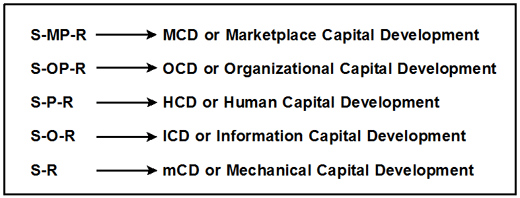
In the NCD Wars, then, Airbus is the Big Winner, due to:
- Exquisite MCD Battlefield Positioning as “The Interdependent Processing Company”;
- Pre-potent OCD Battlefield Formations in continuous interdependent realignment;
- Pre-potent HCD Battlefield Soldiers in interdependent human processors;
- Powerful ICD Battlefield Intelligence in interdependently-generated information modeling;
- Powerful mCD Battlefield Weaponry in interdependently-generated mechanical tooling.
In short, the Process-Centric Company is superior in every form of NCD to the Planning-Centric Company. That is because it “nests” all other forms of NCD in Continuous Marketplace Positioning.
Moreover, the Process-Centric Company is the winner in a competition it did not encourage. It sought the complementary collaboration of the Planning-Centric Company. Indeed, it continues to seek the “Continuous Interdependent Processing Relationship” that empowered its Process-Centricity: Mutual Processing for Mutual Benefit!
In transition, there really is a New Economy undergirding economic growth. We label it “The Possibilities Economy.” Indeed, one of the very reasons that recessions are shallow is the continuous elevation of Economic Productivity Growth or EPG. The sources of this EPG are the most important considerations in developing the Possibilities Economy.
The current financial meaning of the term “capital” notwithstanding, the New Capital Development or NCD ingredients are now the prepotent sources of EPG:
- MCD or Marketplace Positioning,
- OCD or Organizational Alignment,
- HCD or Human Processing,
- ICD or Information Modeling,
- mCD or Mechanical Tooling.
Together, these NCD ingredients have displaced Financial Capital as the most important conditions of EPG. To be sure, financial capital remains a necessary catalyst to growth, accounting for somewhere up to 15% of EPG. However, for most Possibilities Purposes, Financial Capital Development is a means of keeping score.
Together, these emerging NCD ingredients constitute new and expanding economic universes. Together, these emerging NCD ingredients constitute the pre-potent sources of spiraling economic growth. It is as if we are merely in the foothills of a volcanic and exploding mountain range created by the global market, the Internet, and other new platforms of free enterprise.
Of course, the Best Positionings in the Market are those not yet taken:
- Partnered Constellation Positioning with producers, suppliers, and vendors to develop marketplace capital in the changing marketplace;
- Relationship-Driven Marketing Architecture that empowers customer organizations to develop organizational capital;
- Empowered Human Processing Systems that enable people to process interdependently as human capital;
- Multidimensional Information Modeling Systems that yield information capital, which can be processed systematically with human capital;
- Operational Mechanical Tooling Systems that implement information systems-driven mechanical capital.
These positionings truly differentiate the corporation and its products, services, and solutions in the marketplace. They empower the organization and its partners and customers with New Capital Development or NCD. They underscore that the most powerful positioning is substantive positioning: positioning that empowers us to deliver NCD; positioning that enables us to implement NCD; positioning that generates NCD that we can build upon for ourselves and with our friends.
What if the directors from the boardroom of Airbus once again send out their emissaries to Boeing?
“We seek your planning systems to combine with our processing systems.
“Together, we can define the state-of-the-art in customer service.
“We await your response.”
Will Boeing send bureaucrats? Or processors?
It will make all the difference in the NCD Wars!
– R. R. Carkhuff
A Tale of Two Economies.
In The Possibilities Economy.
Amherst, MA: HRD Press, 2005
